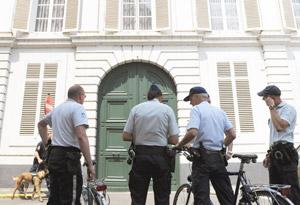The Record
September 22, 2010
http://www.therecord.com.au/site/index.php?option=com_content&task=view&id=1974&Itemid=30
 |
| Police officers stand outside the residence of the archbishop of Mechelen-Brussels in Mechelen, Belgium on 24 June. Belgian investigators searched the headquarters of the Belgian Catholic Church, the Archbishop’s residence as well as the home of Cardinal Godfried Danneels as part of an investigation into alleged priestly sexual abuse. The raid was later declared illegal. |
That most of the accusations of child abuse in the Church are leveled at ordained ministers is a known fact. And that their story bounces immediately on the international media is also part of our experience.
It would be a pity if their story blanketed all the other stories that are enfolding day after day in the Catholic community.
In discussing some of the causes that led to the Protestant Reformation, Daniel-Rops reveals that: "There were undoubtedly very large numbers of saintly individuals in every land and in every walk of life.
This century(15th) of blood and filth produced many shining figures, whose tenderness, charity contrasts remarkably with the attitude of the bulk of their contemporaries and these the Church very rapidly placed upon her altars: Catherine of Siena, St Bridget of Sweden, St Joan of Arc, St Frances of Rome, St Bernardino of Siena and St John Capistrano."
Even in the decades leading up to the Protestant Reformation, it was rather fashionable for preachers to expound on the vices of clergy and Religious, as the subject would captivate the attention of the audience immediately.
"Absenteeism was a far greater problem than immorality; this evil was extremely widespread. The list of clerics who were interested in everything save their sacred duties was a long one, and it included both the most powerful prelates and the humblest parish priests."
Finally, there was another clerical shortcoming which scarcely troubled the average Christian, but which was to have the most serious consequences: ignorance.
"Priests were recruited indiscriminately and hurriedly trained, and far too many possessed a theological knowledge of such rudimentary nature that it was virtually non-existent."
Without attempting to compare clerical standards as they were known to exist then with those of our contemporary situation, I am quite sure that today's standards, even if not perfect, are sufficiently sound to be able to stand up to the scrutiny of analysts both inside and outside the Church.
As reported by Daniel-Rops, even when examining the ups and downs of clerical standards in the Pre-Reformation period, one extremely anti-clerical historian admits that:
"The complaints against the growing vices of the clergy, which were liberally heaped upon the priests of the period, were often inspired by the desire for edification, or by anger and envy rather than by an impartial appreciation of the facts."
One might be tempted to go along with the anti-clerical French historian, Felix Sartiaux, and state quite categorically that there is nothing new under the sun.
In rebuffing the feature article in Time Magazine (7 June, 2010), George Weigel ends his lengthy article with these words: By every available piece of evidence, Ratzinger, in his last half-decade as prefect of the CDF and as Pope, has been determined to root out corruption within the priesthood, while at the same time acknowledging that overwhelming majority of Catholic priests are not sexual predators – a point it would be refreshing to see recognised, in print, by Time and others.
I doubt whether the ideologues of Time and New York Times will heed the advice.
The distortion of facts is not a discovery of 21st century media empires.
Any original material on these pages is copyright © BishopAccountability.org 2004. Reproduce freely with attribution.